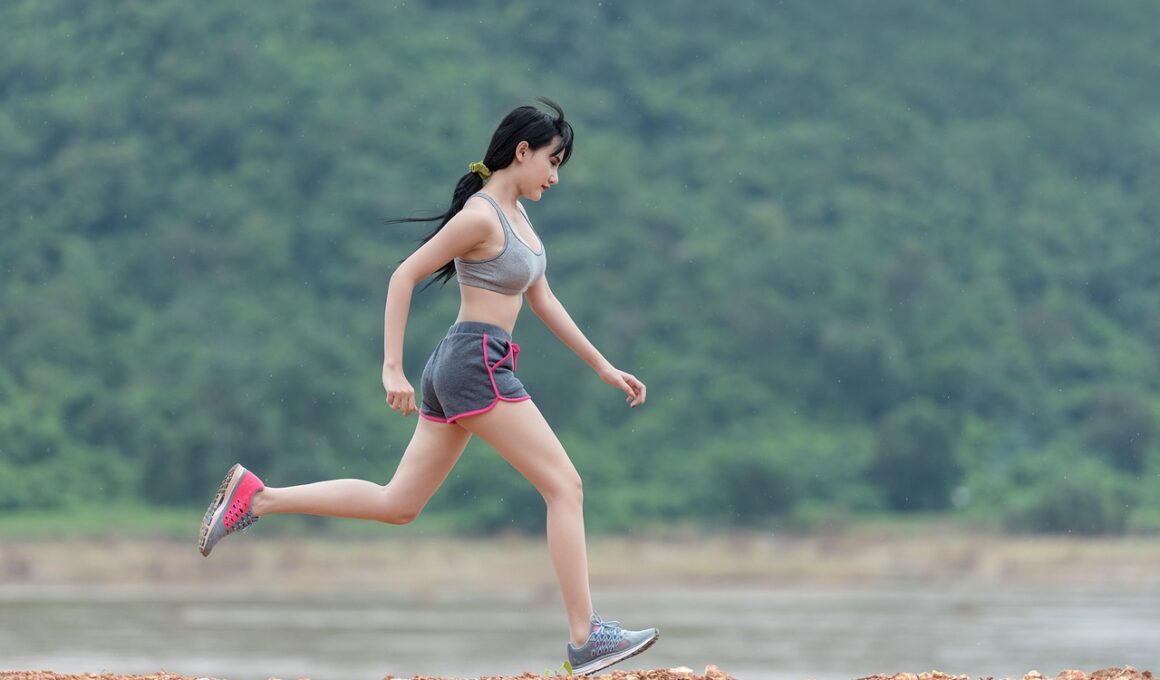How to Dress for Fall Running: Layering Tips
As the leaves change colors and temperatures drop, preparing for fall running is essential. Proper dressing can make your experience enjoyable. Dressing in layers helps to adapt to the varying conditions typical during this season. Start with a base layer made of moisture-wicking materials. This layer should fit snugly against your skin to manage perspiration effectively. Choose fabrics like polyester or merino wool. Next, consider adding a thermal long-sleeve shirt for warmth. A well-fitted, lightweight shirt allows for optimal mobility without overheating. Your outer layer should protect against wind and rain yet be breathable. Windbreakers or lightweight jackets are excellent choices. Accessorize with headgear to maintain warmth. Wearing a beanie or headband can help regulate body temperature and keep you comfortable. Don’t forget about your hands and feet; use running gloves and socks that prevent blisters. Keeping your extremities warm is key to enjoying your runs. Remember, layers can be adjusted; tie extra items around your waist if you get too warm. Dressing properly for fall running enhances comfort and performance, allowing you to enjoy beautiful trails.
Another important factor in dressing for fall running is selecting appropriate footwear. As trails can often be wetter and muddier during autumn, consider using trail running shoes with better traction. These shoes provide stability on slippery surfaces, enhancing safety while running on leaf-covered paths. It’s crucial to choose shoes that fit well to prevent blisters and discomfort during longer runs. Insoles can also enhance comfort, offering extra cushioning and support. For colder days, you might want to invest in shoe covers that help keep your feet warm and dry. Furthermore, keep an eye on the weather forecast before heading out. Having an idea of temperatures and whether rain is likely can significantly impact your clothing choice. It’s wise to layer your clothes according to what is most appropriate for the changing conditions. Consider carrying a lightweight backpack to store layers that you may need to remove as you warm up. This preparation not only makes your run more pleasant but also ensures that you perform your best, regardless of external conditions. Adaptability is key in fall running; having proper gear is essential.
Importance of Accessorizing
Accessorizing plays a significant role in maximizing comfort while running in fall. Wearing a proper hat can protect your head from chilly winds while keeping sweat out of your eyes. Look for hats made from moisture-wicking materials that keep you dry and warm simultaneously. Additionally, consider using a lightweight neck gaiter or buff which can be swiftly adjusted according to temperature changes. These adaptable accessories can provide needed warmth when you start your run and can be removed if you heat up. Reflective gear is also paramount as daylight hours diminish in fall. Adding reflective elements to your running attire increases visibility during early morning or late afternoon runs, ensuring your safety. Non-slip sunglasses are another option to protect your eyes from both sun glare and debris. A well-chosen accessory can improve your overall experience while enhancing your performance on the trails. Training runs require careful thought about not just the clothing but also gear that helps you adapt. Planning your wardrobe ahead allows you to embrace fall running and all the beauty it brings.
If your running routes include beautiful fall landscapes, why not embrace the scenery? Enjoying the surroundings can make your run more pleasurable. However, it’s pivotal to keep comfort at the forefront. Make sure to have a reliable GPS watch or running app to track your performance. Staying aware of your pace can help motivate you to maintain your personal goals. Additionally, keep a bottle of water handy, even on cooler days. Hydration remains vital regardless of the temperature. As the climate can be unpredictable in fall, consider wearing lightweight moisture-wicking pants or capris that allow breathability while offering warmth. Avoid wearing cotton as it retains moisture and can make you feel cold. If running in the evenings, opt for lighter reflective or brightly colored clothing layers to enhance visibility as the sun sets. Ensure the outer layer has pockets for stashing your essentials, like energy gels, keys, or other small items. Being well-equipped can improve your experience as you take on your favorite trails, so focus on what works for you.
Adapting to Changing Weather Conditions
Weather can fluctuate rapidly during fall, impacting how you layer your clothing when running. Be prepared for warm days, chilly mornings, or sudden rain showers. Carrying a lightweight poncho in your running pack can protect you from unexpected rainfall. These keep you dry without adding bulk to your gear. Consider wearing long tights instead of shorts for cooler days. Layering allows you to shed clothes as temperatures increase, so think about what to wear accordingly. During your runs, if you feel too warm, you can easily remove a layer without sacrificing comfort. A fitted tank top can serve as a great base layer in milder weather. Moreover, investing in high-quality running gloves helps maintain warmth in your hands. Look for options designed specifically for running, as they provide dexterity in addition to protection. Staying comfortable allows you to enjoy the beautiful trails and nature that fall brings, so find a layering strategy that suits your personal preference. Your adaptability will lead to a more enjoyable fall running experience.
As your layers adjust throughout your run, consider the type of fabric you wear. Synthetic fabrics like nylon or polyester are often best for athletic wear. These materials wick moisture away from your skin, helping to regulate temperature during activity. Even thermal layers can be made from these excellent synthetic materials, ensuring warmth while remaining lightweight. Pay attention to fit as well. Tight-fitting layers perform better in fabric selection, allowing you to move freely while reducing chafing risk. Look at how layers can complement your movements and maintain comfort throughout the run. Comfort is crucial and can enhance your concentration on performance. In addition, consider maintaining a regular routine in your running schedules. The more consistent you become, the more familiar you will be with managing your layers effectively. Keeping detailed notes on successful outfits can help you plan well for future runs. Flexibility with dressing for fall running can improve your performance, allowing you to embrace the great outdoors. It’s all about finding what works for you! Explore trails while layering properly.
Conclusion: Enjoy Fall Running!
In summary, mastering layering for fall running can dramatically elevate your running experience. Start with moisture-wicking base layers, add insulating mid layers, and finish with protective outer layers. Consider both materials and fit carefully as they significantly impact comfort. Incorporate accessories that enhance visibility and warmth. Enjoy heightened comfort by utilizing trail shoes suitable for the conditions you encounter. As you run through beautiful autumn landscapes, ensure you are aware of weather changes, adjusting layers accordingly. Stay hydrated and maintain control of pace with technology to enhance your training routine. Being adaptable to changing weather conditions will maximize your enjoyment and performance on the trails. Embrace the beauty of fall, focusing on the simple joys of seeing bright colors while you run. Engage in thoughtful planning regarding your running clothes to enhance your overall experience. Stick to your running schedule, documenting the best outfits and adjusting when necessary. Enjoying every step amidst the scenic pathways enhances motivation and the joy of running. Fall running is rewarding, so layer effectively and rejoice in the outdoors!


